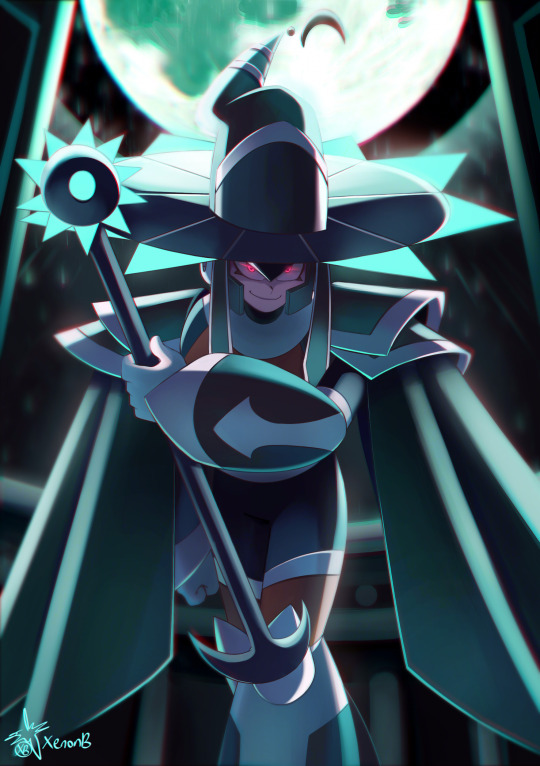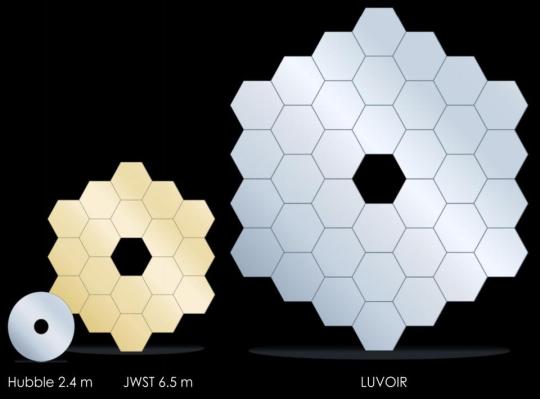#luvoir
Text




My NASA space telescopes-inspired reploids are all together now!
Featuring (left to right): Habex, Luvoir, Lynx and Origins
Habex - The leader. He is the strategist and usually avoids battles but will fight when he has to. Although he looks as though he doesn't take things seriously, he always gets the job done.
Luvoir - The sniper. He was activated before his other siblings due to an error and he left to hunt Mavericks on his own. He eventually became a Maverick himself and reunited with his siblings through battle.
Lynx - The assassin. Unlike Luvoir, she prefers fighting in close hand combat and is stealthy enough to travel around undetected. She was created to work well with Luvoir.
Origins - The navigator. He has very sensitive vision and can detect the slightest movements and changes in the surrounding. Assists his siblings when they battle and will step in to protect them when the battle gets tough.
#oc#original character#character art#character design#xenon art#habex#luvoir#lynx#origins#megaman#rockman#mega man#mega man oc#megaman oc#rockman oc#mega man x#megaman x#rockman x#space#space oc#digital art#reploid#reploid oc
53 notes
·
View notes
Photo






They had a pretty great Christmas! ~
3 notes
·
View notes
Text
Why smart telescopes are the future of astrophotography
Is it time you got a ‘smart telescope’? Interest in space and astronomy has never been greater, but if you’ve ever bought a telescope, you know that setting them up is a pain and often gives you a poor quality view of the night sky.
Credit social media
Instead of being an expert in the night sky, you need to be an expert in how to choose, align and maintain telescopes. It’s an easy way to…

View On WordPress
#4 future space telescopes#astrophotography#astrophotography with phone#evscope telescope review#four future space telescopes nasa wants to build#future telescopes in space#habex space telescope#luvoir telescope nasa#lynx space telescope#lynx x-ray telescope#smarphone astronomy#smart astronomy#smart telescope#smartphone telescope#space telescopes#space telescopes of the future#stellina smart telescope#stellina telescope review
0 notes
Text


The.
Flat fuck.
Happy Flat Fuck Friday to LUVOIR-A specifically.
14 notes
·
View notes
Text
youtube
A Deep Dive Into The Bizarre Future of Telescopes
Hoping to see deeper into the universe, scientists and engineers are designing some of the largest and weirdest telescopes ever conceived. Come with our guest host Astro Alexandra on a tour of the telescopes of the future.
Hosted by: Astro Alexandra
Find Astro Alexandra at https://ift.tt/C2cUMdr
----------
Support SciShow by becoming a patron on Patreon: https://ift.tt/VAxWIPJ
----------
Chapters:
0:00 Intro
1:56 Advantages of utilizing multiple telescopes for comprehensive astronomical research
4:51 The Extremely Large Telescope and the Giant Magellan Telescope
10:36 The Square Kilometer Array Observatory and interferometry
13:58 SPACE TELESCOPES!
14:52 Origins
17:43 LUVOIR
19:47 Habex
21:40 Athena
24:07 SPIDER
25:29 Lunar Crater Radio Telescope
28:57 Sun Based Telescope
30:13 How Telescope technology has changed
31:35 Outro
Correction:
26:40 The image here is actually Opportunity, not Perseverance.
----------
Huge thanks go to the following Patreon supporters for helping us keep SciShow free for everyone forever: Adam Brainard, Alex Hackman, Ash, Benjamin Carleski, Bryan Cloer, charles george, Chris Mackey, Chris Peters, Christoph Schwanke, Christopher R Boucher, DrakoEsper, Eric Jensen, Friso, Garrett Galloway, Harrison Mills, J. Copen, Jaap Westera, Jason A Saslow, Jeffrey Mckishen, Jeremy Mattern, Kenny Wilson, Kevin Bealer, Kevin Knupp, Lyndsay Brown, Matt Curls, Michelle Dove, Piya Shedden, Rizwan Kassim, Sam Lutfi
----------
Looking for SciShow elsewhere on the internet?
SciShow Tangents Podcast: https://ift.tt/RL7xUBw
TikTok: https://ift.tt/RpGYF0d
Twitter: http://www.twitter.com/scishow
Instagram: https://ift.tt/i0Vwoje
Facebook: https://ift.tt/9pJyKfY
#SciShow #science #education #learning #complexly
----------
Sources located at this link:
https://ift.tt/n3TdZi1
via YouTube https://www.youtube.com/watch?v=3xCRLJjSQAA
0 notes
Link
Planning large astronomical missions is a long process. In some cases, such as the now functional James Webb Space Telescope, it can literally take decades. Part of that learning process is understanding what the mission will be designed to look for. Coming up with a list of what it should look for is a process, and on larger missions, teams of scientists work together to determine what they think will be best for the mission. In that vein, a team of researchers from UC Berkeley and UC Riverside have released a paper describing a database of exoplanets that could be worth the time of NASA’s new planned habitable planet survey, the Habitable Worlds Observatory HWO. Astronomy’s decadal surveys are the starting point for many ambitious projects, and the Astro2020 Decadal Survey didn’t disappoint. It called for NASA to develop a 6-meter space telescope capable of high-contrast observations in optical, infrared, and ultraviolet wavelengths. That project became known as the HWO; its primary mission is to observe 25 different exoplanets in their parent star’s habitable zones and look for biosignatures on them. Essentially, it will be humanity’s best alien finder. While not searching biosignatures, it can also do general astronomy, but knowing what planets to look at is critical to its mission. The first in a series of lectures leading up to the advent of the HWO.Credit – STScI Research YouTube Channel To tackle that part of the project, a NASA project known as the Exoplanet Exploration Program developed a list of 164 candidate exoplanets “whose [hypothetical] exo-Earths would be the most accessible” for the HWO. Mainly, that accessibility had to do with the characteristics of the planet’s parent star, but its separation from that star was also considered. While those are helpful characteristics to consider, there are plenty more factors that we believe go into whether a planet is habitable or not. These include the frequency of flares and the abundance of certain elements in the star itself. That is precisely the kind of information the new catalog contains. Specifically, the measurements the authors collected can be broken down into five categories: stellar element abundance, photometric values, flare rates, variability estimates, and X-ray emissions. However, each of those categories has plenty of nuance in it. For example, the researchers collected 1700 stellar measurements of elemental abundance for 14 different elements. However, they could only find X-ray emission data for 41 of the 168 stars in the catalog. Fraser discusses what exoplanet hunting will look like in the future. The lack of data isn’t surprising, as they were simply collecting data from other publicly available sources. Some of those sources focused on thousands of stars and weren’t paying close attention to the ones needed from this data set. Data came from various places, including the Gaia, TESS, and WISE. Even the database itself was modeled on a similar one, known as ExEP Mission Star List (EMSL), that was originally developed for two other Great Observatories, LUVOIR and HabEx. Each has its own specialization, and while there is some overlap with HWO, the data defining those missions wasn’t complete enough to help define HWO. As such, there is still work to do in drawing up a project definition and finalizing the scientific and technical goals for HWO. The authors pointed out that this paper was only the first of a series of precursor papers that would help flesh out what this new observatory would be able to do. Luckily, the catalog they have created is freely available, so any interested party can explore the data they’ve collected and potentially contribute to some of the future work defined at the end of the paper. There’s always more science to be done. Learn More:Harada et al. – Setting the stage for the search for life with the Habitable Worlds Observatory: Properties of 164 promising planet survey targetsUT – Planning is Underway for NASA’s Next Big Flagship Space TelescopeUT – An Ambitious New Technology Might be Needed to See Other EarthsNASA Science – Habitable Worlds Observatory Lead Image:Artist’s illustration of exoplanets The post Astronomers Identify 164 Promising Targets for the Habitable Worlds Observatory appeared first on Universe Today.
0 notes
Text
NASA Unveils Plan for Giant Telescope to Spot Life on Alien Planets
World Observatory
NASA has revealed details about the multi-billion successor to its groundbreaking James Webb Space Telescope (JWST) — a project tasked with searching for life on Earth-like planets as soon as the early 2040s.
During this week's meeting of the American Astronomical Society, Science reports, NASA’s astrophysics division director Mark Clampin revealed that outside of a working name — the spacecraft will be called the Habitable World Observatory (HWO) — most of the details still have to be ironed out.
But it's a momentous occasion nonetheless, revealing a tantalizing vision for the ongoing search for extraterrestrial life.
Alien Hunter
The observatory will be designed from the ground up to be upgradeable by robots, meaning future spacecraft could visit it to upgrade or repair its key components.
If they do, though, it'll be a long tripl. Like the agency's JWST, the HWO will be orbit in a Lagrange Point around the Sun that keeps it near the Earth, roughly a million miles away.
The observatory won't be the next multi-billion dollar telescope NASA launches in the upcoming years. The agency will be launching its dark energy and exoplanet-hunting Nancy Grace Roman Observatory around 2027, if everything goes according to plan.
Mirror, Mirror
There have been several proposals for NASA's HWO so far, including a single segment, 4-meter mirror observatory called HabEx, and a multisegmented, 15-meter observatory dubbed LUVOIR.
The HWO will likely fall something in between those proposals, according to the report, and will feature a mix of technologies inspired by both.
Fortunately, making it serviceable and upgradeable like NASA's Hubble Space Telescope could allow scientists some breathing room and flexibility in its development.
That could also make it more palatable to Congress — which is crucial, given NASA's budget constraints and difficulties in securing funding for its JWST.
READ MORE: NASA unveils initial plan for multibillion-dollar telescope to find life on alien worlds [Science]
More on JSWT: James Webb Captures Its First Look At Saturn's Most Mysterious Moon
The post NASA Unveils Plan for Giant Telescope to Spot Life on Alien Planets appeared first on Futurism.
0 notes
Text
0 notes
Text










Astronomers To NASA: Please, Build This Telescope!
"When the National Academies release their recommendations in just a few weeks, the great hope of astronomers is that at least three of these missions will be chosen to move forward, with LUVOIR, the most powerful and ambitious space-based observatory ever proposed, as the top choice. If we want definitive answers to the biggest questions of all, it takes a big effort and a substantial investment. Considering that the reward is learning that “there’s life on that planet, orbiting another star, right over there,” it’s clear that LUVOIR is the one telescope we must all join together to build."
Seriously, there are dozens, if not hundreds, of potentially habitable Earth-like planets around nearby Sun-like stars. Is there life on them? If we choose to build this next-generation observatory, LUVOIR, we'll know. We won't guess, or speculate, but instead we'll actually know.
NASA, please, build this telescope, and show us whether there's actually life out there on other planets in the nearby Universe!
82 notes
·
View notes
Text








OC paintings so far! They are all based on something space related!
Left to Right:
James Webb (JWST), Trappist (TRAPPIST-1), Spitzer (SST), Chandra (CXO), Discovery (Space Shuttle), Habex (HabEx concept), Lynx (Lynx concept) and Luvoir (LUVOIR concept)
I have more ocs I plan to paint! Hubble and Origins are on the top of my list right now. Hope some of you might be interested to see them!
I also like talking about my ocs so if you want, you can ask me questions about them, or talk to me about anything space related because I love space!
#oc#original character#character design#character art#james webb#trappist#spitzer#chandra#space shuttle#discovery#habex#lynx#luvoir#my art#digital art#xenon art#space
80 notes
·
View notes
Photo




THEM!
0 notes
Link
18 notes
·
View notes
Text
Загрязнение воздуха могло бы свидетельствовать о существовании инопланетян
Планируемый космический телескоп LUVOIR (Large UV Optical Infrared Surveyor) сможет искать внезем... Читать дальше »
0 notes
Photo

Largest space telescope ever fielded, LUVOIR, could aid in search for alien life via /r/space http://ift.tt/2zZ2cC4
2 notes
·
View notes
Photo

thanks for making me into an emoji @luvoir
1 note
·
View note
Note
!!

Here's Compton, a 17776/painterverse oc!
Was assigned sports nerd at some point, but doesn't actually know anything about any sportsballs lol
In one limbo universe, they’re Luvoir’s long suffering babysitter
In painterverse, they’re the concept scopes’ long suffering babysitter
(poor guy)
There’s not much on them because currently doing another project reasons <3 but man did i have a lot of thoughts

in a world a second chances, maybe they’ll get one
(also the wikipedia image of them is so sparkly)

#introduce an oc#not dscp#17776verse compton is alive either as a ghost or little bacteria sort of sense they're not back in the sky#if you want to hear me pacing around about this hmu#like there's this one jon bois quote that was something along the lines of speculating what could have been#and that just lives rent free with compton so#o(-<#ask game answers
6 notes
·
View notes